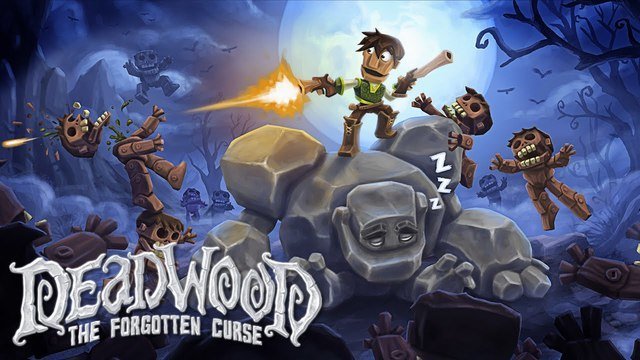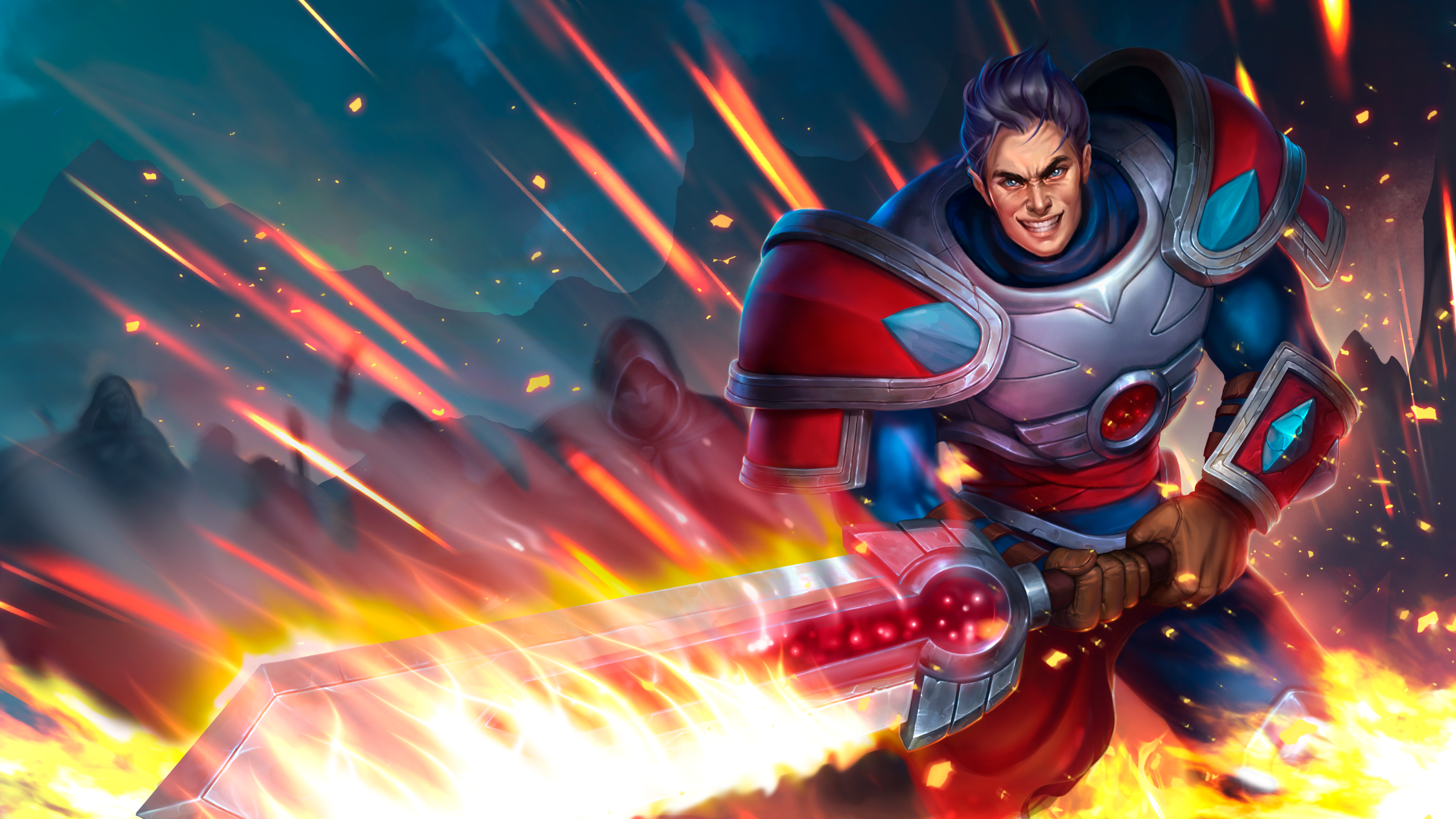You’ve heard of Plants vs. Zombies. But what if the plants were the zombies?
That’s just what you get in Kickstarter up-and-comer Deadwood: The Forgotten Curse, by indie development house Steamroller Studios.
In Deadwood you play as a teenage “woodling” named Lathe, and accompanied by his rock giant pal Roguard, you scavenge for materials to build and protect each other – but by night, when the woodling zombies (the eponymous Deadwood) come out, ready to devour woodlings for their “sap,” Lathe has to be ready to fight them off while Roguard sleeps.
 Be ready when night falls to protect your sleeping pal Roguard from the sap-hungry wooden zombies known as The Deadwood.
Be ready when night falls to protect your sleeping pal Roguard from the sap-hungry wooden zombies known as The Deadwood.
I recently chatted with two of Steamroller Studios’ co-founders – Creative Director Jalil Sadool and Technical Supervisor Keith Lackey – to dig into the roots of this adorable game and talk about its future.
I had so many questions about this game, I almost didn’t know where to start – so I started with the most obvious. Why wooden zombies?
Sadool said that the concept for Deadwood was “a happy accident,” and explained that initially, the project was intended as a zombie survival for mobile devices, and they were limited to some pretty basic shapes; Game Director Adam Meyer had a sketch of one of the zombies, which he had showed first to Lackey.
“Adam basically designed a character with a blocky head,” Sadool told me, “and he brought it to Keith, and Keith said, ‘Hey, uh, this looks like a wooden guy!’ And Adam said, ‘Yeah, that was the idea all along!’ And so that was the birth of the wooden idea.”
I couldn’t help but notice how kid-friendly the world of Deadwood was; this is not your standard zombie survival game, chockful of blood and gore. This, Sadool insisted, has become a point of pride.
“We are all three [Sadool, Lackey and Meyer] fathers and our kids are all very young – and you know, seeing that it’s a very kid-friendly zombie game – there’s no blood, all the blood’s made out of sap, and all the bullets are made out of amber and acorns. So it’s a very child-friendly game, and we’re very proud of that.”
 From story to concept art to animation, a lot of dedicated, passionate work has gone into the creation of Deadwood.
From story to concept art to animation, a lot of dedicated, passionate work has gone into the creation of Deadwood.
The founders of Steamroller Studios have all come from some pretty exciting backgrounds – each has worked on major projects like The Hobbit, How to Train Your Dragon 2, Avatar, and Rise of the Guardians, just to name a few of their well-known works. Deadwood started out as a project they worked on together in their spare time over the course of four or five years (though Sadool said that in terms of actual hours spent, due to their various full-time careers, it was more like six or seven months of actual work). Eventually, though, they realized that Deadwood was their passion, and it was time they came together to work on it full-time.
“It’s such a different thing, working for big companies, doing what they want us to do,” explained Sadool. “There’s only so much input we can have in these big films, awesome as they were. We’ve been doing this for about a decade, and I feel like now, I’m ready to go do my own thing. Adam and Keith as well – they’re ready to go do something big for themselves. We see the opportunity, working together to make something we’re passionate about.”
It was a huge step to take, with each of them living in different parts of the country (and some, like Lackey, in a different part of the world), to drop everything and move to Florida to build their new studio.
Lackey chimed in, “I had to sell my house in New Zealand, get shipping containers to ship all our stuff back here…just for the opportunity to work on something that’s ours. Jalil has very much the same story.”
Striking out on their own as indie developers has its own unique challenges, though. As Sadool noted, “We’re not gonna get a paycheck here – I mean, we are raising money through the Kickstarter, but the paycheck’s not going to be anywhere near what it is in the bigger studios, but that’s not the point. The point is to be making our own creative project and hoping that the world will love it as much as we do.”
 At PAX the Steamroller team saw players building mazes and minefields out of barricades to protect themselves. This led to the Creative Mode stretch goal – a sandbox mode where players can make the game their own.
At PAX the Steamroller team saw players building mazes and minefields out of barricades to protect themselves. This led to the Creative Mode stretch goal – a sandbox mode where players can make the game their own.
And so far, it seems that they do – with a week left to go, Deadwood has exceeded its funding goal, and is working towards its stretch goals – not the least of which is the creative mode feature, which will be added when they reach $85,000. Lackey intimated that this was an idea that they came up with after watching people play the game at PAX. “We saw a lot of people making mazes out of barricades, making minefields…setting up this elaborate system for protecting themselves, and I think we want to give that to the enduser as well – give them the opportunity to design something and hit the play button, and see how that scenario plays out.”
Despite the challenges of indie development, the team at Steamroller Studios really seem to be enjoying the ride, however bumpy it may be. Lackey and Sadool, both having come from larger companies like Weta Digital Ltd and Dreamworks, agreed that working on their own has a lot of benefits. As Sadool explained when I asked what each of their positions on the team entailed, “To be completely honest with you, we put these titles because we have to put titles.” While he is the creative director, everyone on the team has a say in the creative process, and everyone does their part in every aspect of the game’s creation. The titles just give players something to call them when they read the credits.
Lackey, who does all the programming, has also contributed to the creative side of things. As he observed, “I think as an indie, you have to wear a lot of hats, where at the big companies, you’re a specialized tool that they use. While there is often collaboration with all these other departments, you’re kind of a cog in the bigger machine…whereas here, you’re a machine in and of yourself.”
If Deadwood turns out to be the success they’re hoping for, Sadool says they will keep making games. “The three of us, we jumped not only into Deadwood, but into Steamroller. This is our baby, even before Deadwood. We want this company to grow…we want to keep making games. We are very creative people, and we can’t stop ourselves from coming up with more ideas.”
Deadwood: The Forgotten Curse is currently on Kickstarter with a week left to go. You can continue to followSteamroller Studio’s progress on Deadwood and future projects on their website, steamrollerstudios.com.







Published: May 6, 2015 05:18 pm